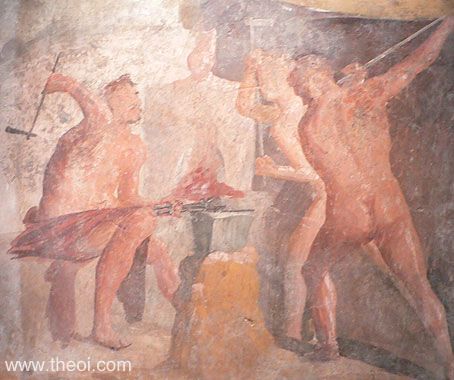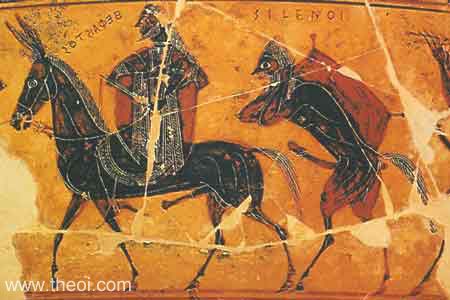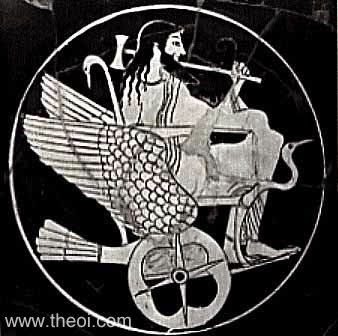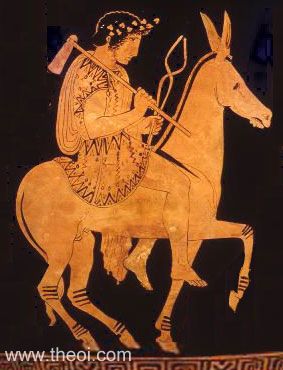HEPHAISTOS ESTATE
Greek Name
Ἡφαιστος
Transliteration
Hêphaistos
Latin Spelling
Hephaestus
Translation
Vulcan

HEPHAISTOS was the Olympian god of fire, smiths, craftsmen, metalworking and stonemasonry.
This page describes the god's estate, attributes, sacred animals, plants and attendants. His main attributes were the hammer and prongs of a smith. His sacred animal was the ass and his plant was the fennel--the hollowed stalk of which was used to transport fire. Hephaistos' forge was attended by the metalworking Kyklopes (Cyclopes) giants.
(1) ESTATE & ATTRIBUTES
PALACE & FORGE ON OLYMPOS The bronze palace of Hephaistos on the heights of Olympos also possessed a small forge.
FORGE ON LEMNOS The god possessed a forge on the Aegean island of Lemnos.
FORGE BY RIVER OKEANOS Hephaistos' first forge was on the shores of the earth-encircling river Okeanos, beside the rising place of the sun.
FORGE ON VOLCANUS Hephaistos had a volcanic forge on Volcanus, one of the Lipari Islands near Sicily, where he was served in his labour by the immortal Kyklopes.
HAMMER & TONGS The tools of his trade, Hephaistos was usually depicted with hammer and tongs in hand.
(2) SACRED PLANTS & ANIMALS
CRANE The crane was the bird of Hephaistos, associated with the god from his time dwelling on the banks of the River Okeanos, where the bird migrated to in the winter. Its long-necked head was often depicted decorating the donkey-saddle or chariot of the god.
DONKEY Hephaistos was frequently depicted in art riding on the back of a donkey.
GUARD-DOG The temple of Hephaistos on Aitna had a pack of sacred dogs.
FENNEL The slow-burning stalk of the fennel was used in ancient times as a torch and a means to transport fire from one place to another. In this way it came to be associated with the god, and his torch-race festivals featured the plant.
(3) ATTENDANTS
KABEIROI (Cabeiri) Two fiery-eyed sons of Hephaistos who worked with the god in his forge on the island of Lemnos.
KEDALION (Cedalion) An young attendant of Hephaistos who worked in the god's forge on the island of Lemnos.
KOURAI KHRYSEAI The golden maidens were animate female statues which attended Hephaistos in his palace and forge on Mount Olympos.
KYKLOPES (Cyclopes) These three one eyed giants and their sons attended the volcanic forges of Hephaistos on Mount Aitna in Sicily and/or the nearby Lipara Islands.
PALIKOI (Palici) Two thermal demi-gods, sons of the Sicilian Hephaistos, who were closely associated with his forge on Mount Aitna or the island of Volcanus. They were closely identified with the Lemnian Kabeiroi.
SATYROI (Satyrs) As a friend and companion of the god Dionysos, Hephaistos was often depicted accompanied by a band of Satyrs.
CLASSICAL LITERATURE QUOTES
PALACE & FORGE ON MT OLYMPUS

The forge of Hephaistos, according to Homer, lay within his palace on Olympos. Others placed it, or alternative forges of the god, on the Aegean island of Lemnos and on the volcanic island of Lipara near Sikleia (Sicily).
Homer, Iliad 18. 136 ff (trans. Lattimore) (Greek epic C8th B.C.) :
"Thetis went onward to Olympos, to bring back to her son the glorious armour . . . [and] came to the house
of Hephaistos imperishable, starry, and shining among the immortals, built in bronze for himself by the god of
the dragging footsteps. She found him sweating as he turned here and there to his bellows busily, since he was
working on twenty tripods which were to stand against the wall of his strong-founded dwelling. And he had set
golden wheels underneath the base of each one so that of their own motion they could wheel into the immortal
gathering, and return to his house: a wonder to look at. These were so far finished, but the elaborate ear
handles were not yet on. He was forging these, and beating the chains out . . . Hephaistos took the huge blower
off from the block of the anvil limping; and yet his shrunken legs moved lightly beneath him. He set the bellows
away from the fire, and gathered and put away all the tools with which he worked in a silver strongbox. Then
with a sponge he wiped clean his forehead, and both hands, and his massive neck and hairy chest, and put on a
tunic, and took up a heavy stick in his hand, and went to the doorway limping. And in support of their master
moved his attendants. These are golden, and in appearance like living young women. There is intelligence in
their hearts, and there is speech in them and strength, and from the immortal gods they have learned how to do
things. These stirred nimbly in support of their master . . .
[Later Hephaistos] went to his bellows. He turned these toward the fire and gave them their orders for working.
And the bellows, all twenty of them, blew on the crucibles, from all directions blasting forth wind to blow the
flames high now as he hurried to be at this place and now at another, wherever Hephaistos might wish them to
blow, and the work went forward. He cast on the fire bronze which is weariless, and tin with it and valuable
gold, and silver, and thereafter set forth upon its standard the great anvil, and gripped in one hand the
ponderous hammer, while in the other he grasped the pincers."
Homer, Odyssey 8. 267 ff (trans. Shewring) (Greek epic C8th B.C.) :
"He [Hephaistos] went to the room where his bed lay; all round the bed-posts he dropped the chains [to trap
his adulterous wife], while others in plenty hung from the roof-beams . . . Once he [Ares] had seen Hephaistos
go, he himself approached the great craftman's dwelling, pining for love of Kytherea [Aphrodite]. As for her,
she had just returned from the palace of mighty Zeus her father, and was sitting down in the house as Ares
entered it."
Apollonius Rhodius, Argonautica 3. 36 ff (trans. Rieu) (Greek epic C3rd B.C.)
:
"The palace of Aphrodite, which her lame consort Hephaistos had built for her when he took her as his bride
from the hands of Zeus. They [Hera and Athene] entered the courtyard and paused below the veranda of the room
where the goddess slept with her lord and master."
Virgil, Aeneid 8. 372 ff (trans. Day-Lewis) (Roman epic C1st B.C.) :
"Venus [Aphrodite] . . . spoke to her husband, Volcanos [Hephaistos], as they lay in their golden
bed-chamber."
For MORE information on the home of the gods see OLYMPOS
FORGE OF ON LEMNOS
Cicero, De Natura Deorum 3. 22 (trans. Rackham) (Roman rhetorician C1st B.C.)
:
"Volcanos [Hephaistos] . . . is the son of . . . Jupiter [Zeus] and of Juno [Hera], and is fabled to have
been the master of a smithy at Lemnos."
Statius, Silvae 3. 1. 130 (trans. Mozley) (Roman poetry C1st A.D.) :
"Nor [does a] greater noise [come] from the Lemnian caves when Mulciber [Hephaistos] amid his flames forges
the aegis and makes chaste gifts for Pallas."
Nonnus, Dionysiaca 14. 17 ff (trans. Rouse) (Greek epic C5th A.D.) :
"From the firepeak rock of Lemnos the two Kabeiroi in arms . . . two sons of Hephaistos whom Thrakian
Kabeiro had borne to the heavenly smith, Alkon and Eurymedon well skilled at the forge."
FORGE ON THE LIPARA ISLANDS OR MOUNT ETNA

Hephaistos was identified by the Greeks with the south Italian volcano-gods Adranos-Volcanos. Late classical writers following this idea describe a forge of the god on the volcanic Lipari islands near Sicily, where he was said to have been attended in his labours by the Kyklopes. Sometimes the forge was placed on the peak of Mt Atina instead.
Apollonius Rhodius, Argonautica 3. 36 ff (trans. Rieu) (Greek epic C3rd B.C.)
:
"Hephaistos himself had gone early to his forge and anvils in a vast cavern on a floating island [of
Lipara], where he used to turn out all kinds of curious metalwork with the aid of fire and bellows."
Apollonius Rhodius, Argonautica 4. 760 ff :
"[Hera addresses Iris :] ‘Go to the seacoast [islands near Sicily] where the bronze anvils of
Hephaistos are pounded by his mighty hammers, and tell him to let this bellows sleep till Argo has passed by . .
.'
Iris, spreading her light pinions, swooped down from Olympos and cleft the air . . . She went to Hephaistos and
easily persuaded him to rest. The iron hammers ceased, the smoky bellows blew no more . . .
The Argonauts sailed on in gloom . . . great seas were booming on the Wandering Rocks, where but a little
earlier flames from the glowing lava had shot up above the crags, and a pall of smoke had hidden the sun. By now
Hephaistos had ceased to work; but even so hot vapour was still rising from the sea . . . [and the Argonauts
passed safely through the Wandering Rocks].
They were watched by the Lord Hephaistos himself, standing on the summit of a smooth rock and resting his great
shoulder on the haft of his hammer."
Callimachus, Hymn 3 to Artemis 46 ff (trans. Mair) (Greek poet C3rd B.C.)
:
"And straightway she [Artemis] went to visit the Kyklopes. Then she found in the isle of Lipara--Lipara in
later days, but at that time its name was Meligounis - at the anvils of Hephaistos, standing round a molten mass
of iron."
Euphorion, Fragments (trans. Page, Vol. Select Papyri III, No. 121 (1)) (Greek epic
C3rd B.C.) :
"Truly in the Forges or in Meligounis [i.e. Lipara] leap such sparks into the air, when iron is beaten with
hammers, and the anvil roars beneath might blows,--or up inside smoke Aitna, lair of Asteropos [i.e.
Hephaistos]."
Strabo, Geography 6. 2. 10 (trans. Jones) (Greek geographer C1st B.C. to C1st A.D.)
:
"Between Lipara and Sikelia (Sicily) is [the island of] Thermessa, which is now called Hiera of Hephaistos
[or Volcanus in Latin]; the whole island is rocky, desert, and fiery, and it has three fire blasts, rising from
three openings which one might call craters. From the largest the flames carry up also red-hot masses, which
have already choked up a considerable part of the Strait."
Philostratus, Life of Apollonius of Tyana 5. 16 (trans. Conybeare) (Greek biography
C1st to 2nd A.D.) :
"Poetical myths are given by the vulgar of Aitna . . . belonging to the class of dramatic stories which
fill the mouths of our poets. For they say that a certain Typho or Enkelados lies bound under the mountain . . .
Nor can I any more respect that other story, thought it is more reverent in its tone, to the effect that
Hephaistos attends his forge in Aitna, and that there is there an anvil on which he smites with his
hammer."
Virgil, Aeneid 8. 372 ff (trans. Day-Lewis) (Roman epic C1st B.C.) :
"As soon as he [Hephaistos] had woken, rested, requiring to sleep no longer in the small hours when night
was waning . . . did the Fire-lord rise from his downy bed and go to his ironworks.
Between the Sicilian coast and Aeolian Lipara there's an island, whose cliffs, sheer-rising, jet out smoke from
their crannies: deep within it are vaults, a rumbling volcanic cavern scooped out by the action of the Cyclopes'
fires; you can hear the clang of hard blows on the anvils, the roaring when masses of ore are smelted within,
and a throbbing blast of flame form the furnaces. Here is Volcanos' [Hephaistos'] place; the island is called
Volcania. Hither now the Fire-god repaired form heaven above. The Cyclopes were hard at work in this underground
iron-foundry--Brontes and Steropes, Pyracmon stripped to the buff. They manufactured a thunderbolt, such as the
Father of heaven [Zeus] shoots down in such great numbers at earth from all over the sky: part of it was already
streamlined, part unfinished. They had given it three fins of twirling sleet, and three of cloudburst, three of
russet fire and three of stormwind. Now they were putting in as components frightening flashes, the noise that
creates panic, the piercing flames of wrath. Elsewhere, a job was being hurried on for Mars [Ares]--a chariot
with swift wheels, such as he rides in to rouse up men and nations. Some busily burnished the aegis Athene wears
in her angry moods--a fearsome thing with a surface of gold like scaly snake-skin, and he linked serpents and
the Gorgon herself upon the goddess' breast--a severed head rolling its eyes.
‘Put all that work aside, pack in the jobs you're engaged on, you Cyclopes of Mount Aetna, and turn your
attention to this--the making of arms for a hot-blooded hero [Aeneas]! Now there is need for your strength, your
speediest work and your master-craftmanship. Get bustling on it at once!’
That was all Volcanos [Hephaistos] said: quickly they set to the business, shared out the tasks among them
equally. Rivers of molten bronze and gold are flowing; the deadly steel is smelted in an immense furnace. They
fashion a shield of heroic size, to withstand by itself every missile the Latins can use, welding seven round of
metal one on another to make it. Some pump away at the bellows, drawing in air and expelling it; some dip the
hissing metal in troughs. The cavern groans under the stress of anvils. They raise their arms with the powerful
alternate rhythm of cranks, they keep the iron-ore turning in the close grip of their tongs."
Cicero, De Natura Deorum 3. 22 (trans. Rackham) (Roman rhetorician C1st B.C.)
:
"There are also several Volcanus's [Hephaistos's] . . . the fourth [the Italian god Adranus or Volcanus] is
the son of Memalius, and lord of the islands near Sicily which used to be named the Isles of Volcanus [the
Lipari islands]."
Statius, Silvae 3. 1. 130 (trans. Mozley) (Roman poetry C1st A.D.) :
"Not so loud is Aetna's din, when the anvils are busy and Brontes and Steropes ply the hammer, nor greater
noise from the Lemnian caves when Mulciber [Hephaistos] amid his flames forges the aegis and makes chaste gifts
for Pallas."
Nonnus, Dionysiaca 29. 348 ff (trans. Rouse) (Greek epic C5th A.D.) :
"Set foot in Sikelia (Sicily), put your prayer, if you please, to the Kyklopes standing by their forge.
They are in the secrets of Hephaistos the master craftsman, they can rival his clever work."
Nonnus, Dionysiaca 30. 42 ff :
"[The Kabeiros] Eurymedon called upon his Lemnian father [Hephaistos] . . . : ‘O Father,
firebreathing lord of our laborious art! Grant me the boon once earned, when Deo [Demeter] of the
threshing-floor alone seized threecliff Sikelia (Sicily), as sightingprize for Persephoneia hidden there, and
knocked over your windblown bellows in the west and your wide forge and gripping tongs : but I defended my
father and scared her off, protecting your anvil. You owe it to me that the air is black and hot with your
Sikelian sparks!’"
[N.B. The Lemnian Kabeiroi are here identified with the Sicilian Palikoi, twin sons respectively of Hephaistos
and his Italian counterpart Adranus-Volcanus.]
SACRED BIRDS & ANIMALS

I. DONKEY (Greek onos)
Hephaistos was frequently depicted in Greek art riding on the back of a donkey, from scenes of his return to Olympos in the company of Dionysos, to the War of the Giants and the Wedding of Peleus and Thetis.
II. GUARD-DOG (Greek kyon)
Aelian, On Animals 11. 3 (trans. Schofield) (Greek natural history C2nd to 3rd A.D.)
:
"At Aitna in Sikelia (Sicily) honour is paid to a temple of Hephaistos, and there are a precinct, sacred
trees, and a fire that is never extinguished, never sleeps. And about the temple and the grove there are sacred
Hounds which greet and fawn upon such as pass into the temple and the grove with honest hearts in seemly fashion
as is their duty, as though the animals had a kindness for them and presumably recognised them. If however a man
has his hands stained with crime, they bite and tear him, whereas those who only come from the bed of debauchery
they simply chase away."
III. CRANE (Greek geranos)
The crane was closely associated with Hephaistos, for the god was said to have dwelt on the shores of the earth-encircling River Okeanos in his early days, the wintering grounds of the migrating crane. His donkey-saddle or chariot was often depicted decorated with crane-heads.
ATTENDANTS : THE GOLDEN MAIDENS
The Golden Maidens attended Hephaistos in his palace and forge on Mount Olympos.
Homer, Iliad 18. 136 ff (trans. Lattimore) (Greek epic C8th B.C.) :
"Thetis of the silver feet came to the house of Hephaistos [on Mount Olympos] . . . [and Hephaistos came]
to the doorway limping. And in support of their master moved his attendants. These are golden, and in appearance
like living young women. There is intelligence in their hearts, and there is speech in them and strength, and
from the immortal gods they have learned how to do things. These stirred nimbly in support of their master, and
moving near to where Thetis sat in her shining chair, Hephaistos caught her [Thetis] by the hand."
Philostratus, Life of Apollonius of Tyana 6. 11 (trans. Conybeare) (Greek biography
C1st to 2nd A.D.) :
"Hephaistos . . . constructed handmaids of gold . . . he made the gold breathe."
For MORE information on the golden maidens see KOURAI KHRYSEAI
ATTENDANTS : CEDALION
Kedalion was a servant of Hephaistos in his forge on the island of Lemnos.
Hesiod, The Astronomy Fragment 4 (from Pseudo-Eratosthenes, Catasthenes Fragment 32)
(trans. Evelyn-White) (Greek epic C8th or 7th B.C.) :
"[Oinopion] blinded him [Orion for raping his daughter] and cast him out of the country. Then he came to
Lemnos as a beggar and there met Hephaistos who took pity on him and gave him Kedalion his own servant to guide
him. So Orion took Kedalion upon his shoulders and used to carry him about while he pointed out the roads."
Pseudo-Apollodorus, Bibliotheca 1. 26 - 27 (trans. Aldrich) (Greek mythographer C2nd
A.D.) :
"[Oinopion king of Khios] blinded him [Orion, for raping his daughter] and tossed him out on the beach. He
made his way to the bronze workshop of Hephaistos [on the island of Lemnos] and seized a boy [Kedalion], set him
on his shoulder, and ordered him to guide him towards the east."
Pseudo-Hyginus, Astronomica 2. 34 (trans. Grant) (Roman mythographer C2nd A.D.)
:
"He [Orion] was blinded by Oenopion [for raping his daughter] and cast out of the island of Chios. But he
came to Lemnos and Volcanus [Hephaistos], and received from him a guide named Cedalion. Carrying him on his
shoulders, he came to Sol [Helios]."
For more information on this daimon see KEDALION
ATTENDANTS : CABEIRI & PALICI
Hephaistos twin sons the Kabeiroi assisted their father in his forge on the island of Lemnos. They were closely identified with the Palikoi, another set of Hephaistian twins, who attended his Sicilian forge.
Nonnus, Dionysiaca 14. 17 ff (trans. Rouse) (Greek epic C5th A.D.) :
"From the firepeak rock of Lemnos the two Kabeiroi in arms . . . two sons of Hephaistos whom Thrakian
Kabeiro had borne to the heavenly smith, Alkon and Eurymedon well skilled at the forge."
Nonnus, Dionysiaca 30. 42 ff :
"[The Kabeiros] Eurymedon called upon his Lemnian father [Hephaistos] . . .: ‘O Father, firebreathing
lord of our laborious art! Grant me the boon once earned, when Deo [Demeter] of the threshing-floor alone seized
threecliff Sikelia (Sicily), as sightingprize for Persephoneia hidden there, and knocked over your windblown
bellows in the west and your wide forge and gripping tongs : but I defended my father and scared her off,
protecting your anvil. You owe it to me that the air is black and hot with your Sikelian
sparks!’"
[N.B. The Lemnian Kabeiroi are here identified with the Sicilian Palikoi, twin sons respectively of Hephaistos
and his Italian counterpart Adranus-Volcanus.]
For MORE information on these gods see KABEIROI and PALIKOI
ATTENDANTS : THE CYCLOPES
The three immortal Kyklopes (and their sons) worked in the forge of Hephaistos on the island of Volcanus near Sicily.
Callimachus, Hymn 3 to Artemis 46 ff (trans. Mair) (Greek poet C3rd B.C.)
:
"And straightway she [Artemis] went to visit the Kyklopes. Then she found in the isle of Lipara--Lipara in
later days, but at that time its name was Meligounis--at the anvils of Hephaistos, standing round a molten mass
of iron."
Virgil, Aeneid 8. 372 ff (trans. Day-Lewis) (Roman epic C1st B.C.) :
"Between the Sicilian coast and Aeolian Lipare there's an island, whose cliffs, sheer-rising, jet out smoke
from their crannies: deep within it are vaults, a rumbling volcanic cavern scooped out by the action of the
Cyclopes' fires; you can hear the clang of hard blows on the anvils, the roaring when masses of ore are smelted
within, and a throbbing blast of flame form the furnaces. Here is Volcanos' [Hephaistos'] place; the island is
called Volcania. Hither now the Fire-god repaired form heaven above. The Cyclopes were hard at work in this
underground iron-foundry--Brontes and Steropes, Pyracmon stripped to the buff . . .
‘Put all that work aside, pack in the jobs you're engaged on, you Cyclopes of Mount Aetna, and turn your
attention to this--the making of arms for a hot-blooded hero [Aeneas]! Now there is need for your strength, your
speediest work and your master-craftmanship. Get bustling on it at once!’
That was all Volcanos [Hephaistos] said: quickly they set to the business, shared out the tasks among them
equally."
Statius, Thebaid 2. 265 ff (trans. Mozley) (Roman epic C1st A.D.) :
"The Lemnian [Hephaistos], so they of old believed, long time distressed at Mars' [Ares'] deceit and seeing
that no punishment gave hindrance to the disclosed armour . . . wrought this [fabulous necklace] for Harmonia on
her bridal day to be the glory of her dower. Thereat, though taught mightier tasks, the Cyclopes labour, and the
Telchines famed for their handiwork helped in friendly rivalry of their skill; but for himself the sweat of toil
was heaviest."
Statius, Silvae 3. 1. 130 (trans. Mozley) (Roman poetry C1st A.D.) :
"Not so loud is Aetna's din, when the anvils are busy and Brontes and Steropes ply the hammer."
For MORE information on these giants see KYKLOPES
SOURCES
GREEK
- Homer, The Iliad - Greek Epic C8th B.C.
- Homer, The Odyssey - Greek Epic C8th B.C.
- Hesiod, Astronomy Fragments - Greek Epic C8th - 7th B.C.
- Apollodorus, The Library - Greek Mythography C2nd A.D.
- Apollonius Rhodius, The Argonautica - Greek Epic C3rd B.C.
- Callimachus, Hymns - Greek Poetry C3rd B.C.
- Greek Papyri III Euphorion, Fragments - Greek Epic C3rd B.C.
- Strabo, Geography - Greek Geography C1st B.C. - C1st A.D.
- Aelian, On Animals - Greek Natural History C2nd - 3rd A.D.
- Philostratus, Life of Apollonius of Tyana - Greek Biography C2nd A.D.
- Nonnus, Dionysiaca - Greek Epic C5th A.D.
ROMAN
- Hyginus, Astronomica - Latin Mythography C2nd A.D.
- Virgil, Aeneid - Latin Epic C1st B.C.
- Cicero, De Natura Deorum - Latin Rhetoric C1st B.C.
- Statius, Thebaid - Latin Epic C1st A.D.
- Statius, Silvae - Latin Poetry C1st A.D.
BIBLIOGRAPHY
A complete bibliography of the translations quoted on this page.